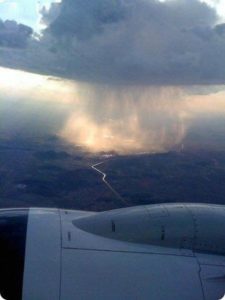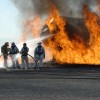Meteorology
[audio:https://aviationenglishblog.com/wp-content/uploads/2010/09/Meteorology.mp3|titles=Meteorology]TOPIC: Meteorology
GOAL: To learn about aviation meteorology and its role in aviation safety
Exercise #1: Read about aviation meteorology and then proceed to Exercise #2
Meteorology is the interdisciplinary scientific study of the atmosphere that focuses on weather processes and short term forecasting (in contrast with climatology). Aviation meteorology (MET) deals with the impact of weather on Air Traffic Management (ATM). It is important for air crews to understand the implications of weather on their flight plan as well as their aircraft.
Weather conditions concern all aspects of ATM operations, for example, by variations in head and tail-wind components, through changes in pressure and temperature values at airports, and in imposing low visibility operating conditions. Adverse meteorological conditions have the greatest impact on the ATM system creating disruption and the consequent problems of disturbed flow rates, lost capacity and induced additional costs
 One of the greatest threats to aircraft operations are thunderstorms. Relatively recent meteorological studies have confirmed the existence of microburst phenomenon around these dangerous weather phenomena. Microbursts are small scale intense downdrafts which, on reaching the surface, spread outward in all directions from the downdraft center. This causes the presence of both vertical and horizontal wind shears that can be extremely hazardous to all types and categories of aircraft, especially at low altitudes. Due to their small size, short life span, and the fact that they can occur over areas without surface precipitation, microbursts are not easily detectable using conventional weather radar or wind shear alert systems.
One of the greatest threats to aircraft operations are thunderstorms. Relatively recent meteorological studies have confirmed the existence of microburst phenomenon around these dangerous weather phenomena. Microbursts are small scale intense downdrafts which, on reaching the surface, spread outward in all directions from the downdraft center. This causes the presence of both vertical and horizontal wind shears that can be extremely hazardous to all types and categories of aircraft, especially at low altitudes. Due to their small size, short life span, and the fact that they can occur over areas without surface precipitation, microbursts are not easily detectable using conventional weather radar or wind shear alert systems.
The life cycle of a microburst as it descends in a convective rain shaft .An important consideration for pilots is the fact that the microburst intensifies for about 5 minutes after it strikes the ground. Parent clouds producing microburst activity can be any of the low or middle layer convective cloud types. Note, however, that microbursts commonly occur within the heavy rain portion of thunderstorms, and in much weaker, benign appearing convective cells that have little or no precipitation reaching the ground.
Characteristics of microbursts include:
1. Size. The microburst downdraft is typically less than 1 mile in diameter as it descends from the cloud base to about 1,000-3,000 feet above the ground. In the transition zone near the ground, the downdraft changes to a horizontal outflow that can extend to approximately 2 1/2 miles in diameter.
2. Intensity. The downdrafts can be as strong as 6,000 feet per minute. Horizontal winds near the surface can be as strong as 45 knots resulting in a 90 knot shear (headwind to tailwind change for a traversing aircraft) across the microburst. These strong horizontal winds occur within a few hundred feet of the ground.
3. Visual Signs. Microbursts can be found almost anywhere that there is convective activity. They may be embedded in heavy rain associated with a thunderstorm or in light rain in benign appearing virga. When there is little or no precipitation at the surface accompanying the microburst, a ring of blowing dust may be the only visual clue of its existence.
4. Duration. An individual microburst will seldom last longer than 15 minutes from the time it strikes the ground until dissipation. The horizontal winds continue to increase during the first 5 minutes with the maximum intensity winds lasting approximately 2-4 minutes. Sometimes microbursts are concentrated into a line structure, and under these conditions, activity may continue for as long as an hour. Once microburst activity starts, multiple microbursts in the same general area are not uncommon and should be expected.
Microburst wind shear may create a severe hazard for aircraft within 1,000 feet of the ground, particularly during the approach to landing and landing and take-off phases. The impact of a microburst on aircraft can be sever as the aircraft may encounter a headwind (performance increasing) followed by a downdraft and tailwind (both performance decreasing), possibly resulting in terrain impact.
Exercise #2: Watch these videos about aviation meteorology, and then proceed to Exercise #3
1. An overall look at the aviation and its important relationship with weather
Watch video
2. A short video lesson on understanding thunderstorms
Watch video
3. This video shows the most common types of clouds pilots see.
Watch video
Exercise #3: Matching: Using the following vocabulary list, match the lettered clouds in the diagram with the appropriate terminology.
| Cirrus | Alto-cumulus | |
| Stratus | Stratus-cumulus | |
| Cumulus | Nimbo-stratus | |
| Cirro-stratus | Alto-stratus | |
| Cirro-cumulus | Cumulo-nimbus |
A___________
B___________
C___________
D___________
E___________
F___________
G___________
H___________
I ___________
J _____________
Answers: (A) cirrus-stratus (B) cirrus (C) cirro-cumulus (D) alto-stratus (E) cumulus (F) alto-cumulus (G)stratus (H) nimbo-stratus (I) cumulo-nimbus (J) strato-cumulus
Click here to know about the parts of the aircrafts and improve your Aviation English vocabulary!

















Wow at last I found a meteorology site. I am doing 1st year in BSc Meteorology and want to specialise in aviation meteorology(I so love it). I have been searching the web for days looking for fellow meteorologists. I wish that one day i can be allowed to go visit airpots and just have a day with Avitiation Meteorologists and see what exactly they are doing.
Thank you for this WONDERFUL WEBSITE!!!